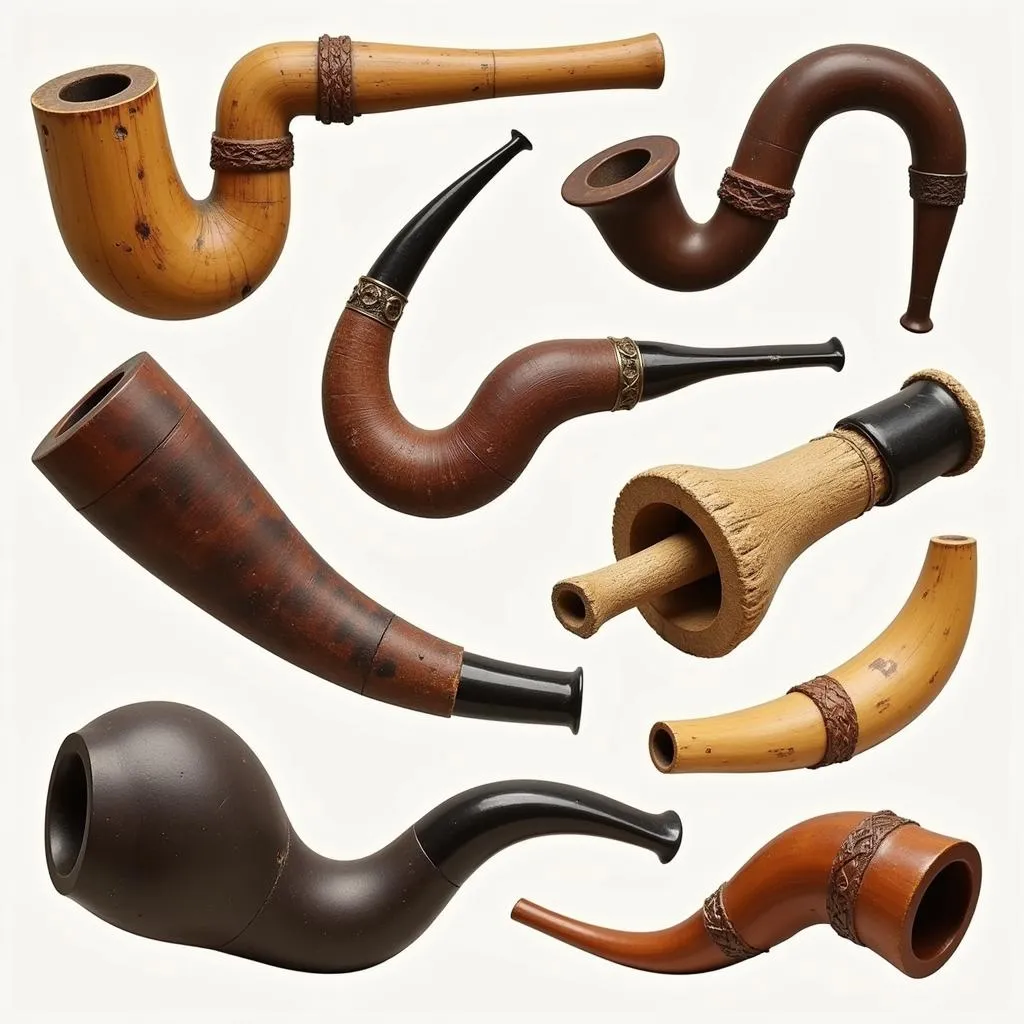The Alluring Sounds of the African Flue Pipe
The African Flue Pipe, a captivating instrument steeped in tradition, echoes the heart and soul of the continent. It’s more than just a musical instrument; it’s a storyteller, a cultural emblem, and a bridge connecting generations. Its haunting melodies transport listeners to vast savannas, bustling marketplaces, and intimate gatherings, where music weaves the fabric of life.
A Symphony of Shapes and Sounds
The term “African flue pipe” encompasses a diverse family of wind instruments, each with unique characteristics and regional variations. Unlike Western flutes, which typically rely on a side-blown embouchure, most African flue pipes are end-blown, similar to a recorder or a whistle. This design creates a distinctive breathy and resonant sound that defines their sonic landscape.
Exploring the Instrument Family
From the soaring notes of the Fulani flute to the mellow whispers of the Mbira Dzavadzimu, African flue pipes showcase an impressive array of forms and materials. Some are crafted from natural materials like bamboo, reeds, and animal horns, while others utilize wood, metal, or even gourds.
 African Flue Pipe Variety
African Flue Pipe Variety
The length and number of finger holes on the pipe dictate its pitch and range, allowing for a wide spectrum of musical expressions. Certain instruments feature additional components, such as resonators or gourds, to enhance their volume or create unique tonal qualities.
A Musical Legacy: Cultural Significance
Across Africa, flue pipes hold profound cultural significance, interwoven into the very fabric of life. They accompany rituals, ceremonies, storytelling sessions, and social gatherings.
 African Flue Pipe Ceremony
African Flue Pipe Ceremony
The music produced by these instruments transcends mere entertainment; it carries ancestral wisdom, historical narratives, and emotional expressions passed down through generations.
The Craft of Creation: Building an African Flue Pipe
The creation of an African flue pipe is more than a mere act of construction; it’s an art form requiring skilled craftsmanship and a deep understanding of acoustics and materials.
From Nature to Instrument: Sourcing and Shaping
Artisans meticulously select natural materials like bamboo, reeds, or wood, paying close attention to their diameter, straightness, and resonance qualities. The chosen material is then carefully carved, hollowed out, and shaped to create the pipe’s body.
Finger holes are strategically placed to produce specific pitches, and the instrument’s mouthpiece is precisely crafted for optimal airflow and sound production.
Adornment and Personalization
Beyond functionality, African flue pipes are often adorned with intricate carvings, beadwork, or symbolic motifs. These embellishments reflect the cultural heritage of the maker and imbue the instrument with spiritual significance.
The African Flue Pipe in the Modern World
While deeply rooted in tradition, the African flue pipe continues to evolve in the contemporary music scene.
Blending Tradition and Innovation
Musicians are experimenting with new materials, techniques, and musical styles, pushing the boundaries of the instrument’s capabilities. Some are incorporating elements of jazz, classical, and world music into their compositions, creating unique fusions that captivate audiences worldwide.
 African Flue Pipe Modern Musician
African Flue Pipe Modern Musician
Preserving a Cultural Heritage
Efforts are underway to preserve the traditional craftsmanship and musical knowledge associated with African flue pipes. Workshops, apprenticeships, and cultural festivals play a crucial role in transmitting these skills to younger generations, ensuring the continuity of this rich musical heritage.
Conclusion
The African flue pipe stands as a testament to the continent’s vibrant and diverse musical heritage. Its haunting melodies, intricate craftsmanship, and deep cultural significance continue to captivate audiences worldwide. As we listen to the evocative sounds of the African flue pipe, we embark on a journey through time, connecting with the rich tapestry of African culture and the enduring power of music.
FAQ
1. What is the most common type of African flue pipe?
The Fulani flute, also known as the serdu, is one of the most widely recognized African flue pipes, particularly in West Africa.
2. Can African flue pipes be played in ensembles?
Yes, African flue pipes are often played in ensembles, creating complex polyphonic textures and rhythmic patterns.
3. Are African flue pipes used in any modern music genres?
Yes, African flue pipes are increasingly being incorporated into contemporary music genres such as jazz, world music, and experimental music.
4. Where can I learn to play an African flue pipe?
There are various resources available for learning to play African flue pipes, including online tutorials, workshops, and private lessons.
5. Are African flue pipes difficult to learn?
Like any instrument, learning to play an African flue pipe requires patience and practice. However, the basic techniques can be relatively easy to grasp.
Other Related Articles
If you need further assistance, please do not hesitate to contact us at +255768904061, email us at kaka.mag@gmail.com, or visit us at Mbarali DC Mawindi, Kangaga, Tanzania. Our team is available 24/7 to help you.

